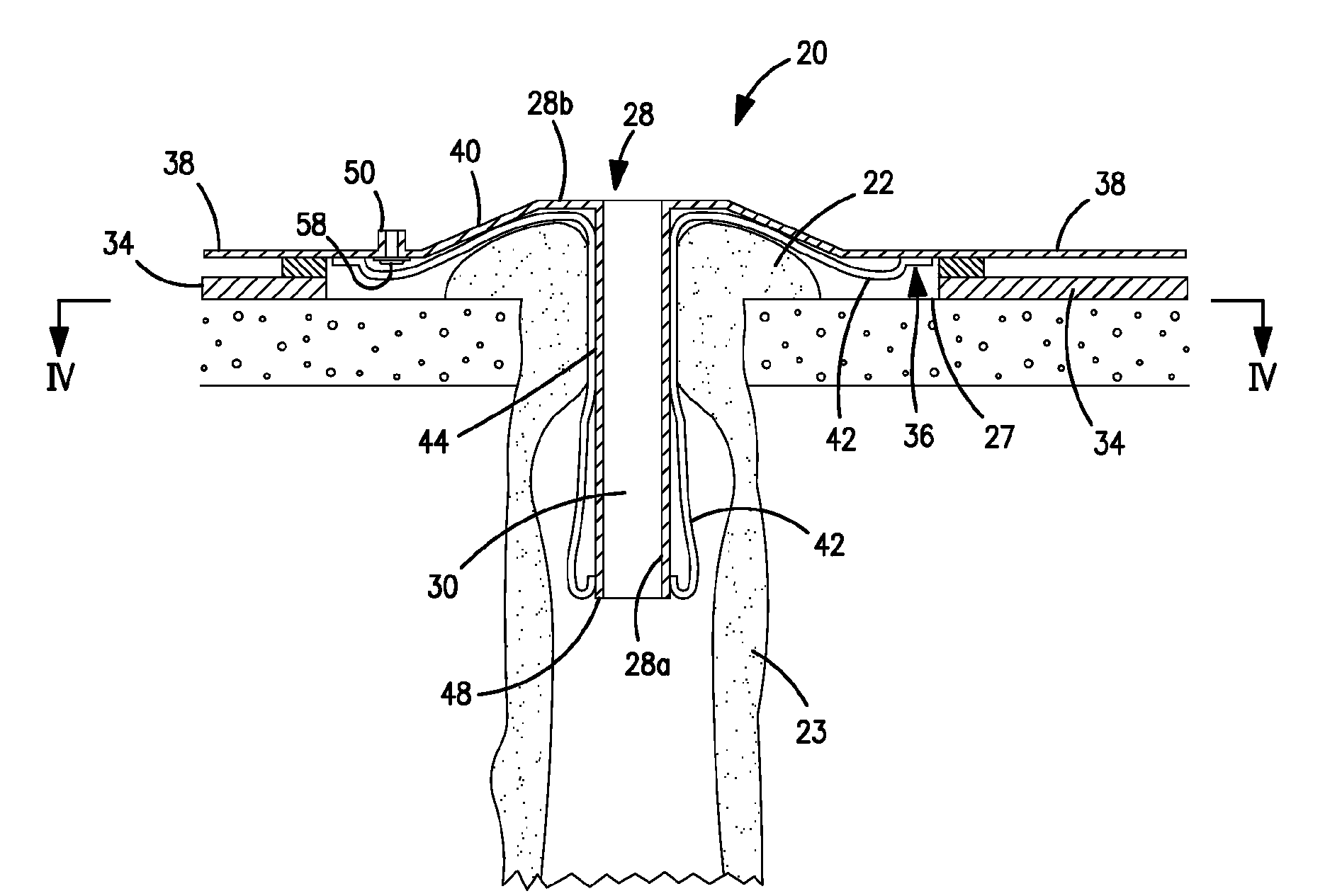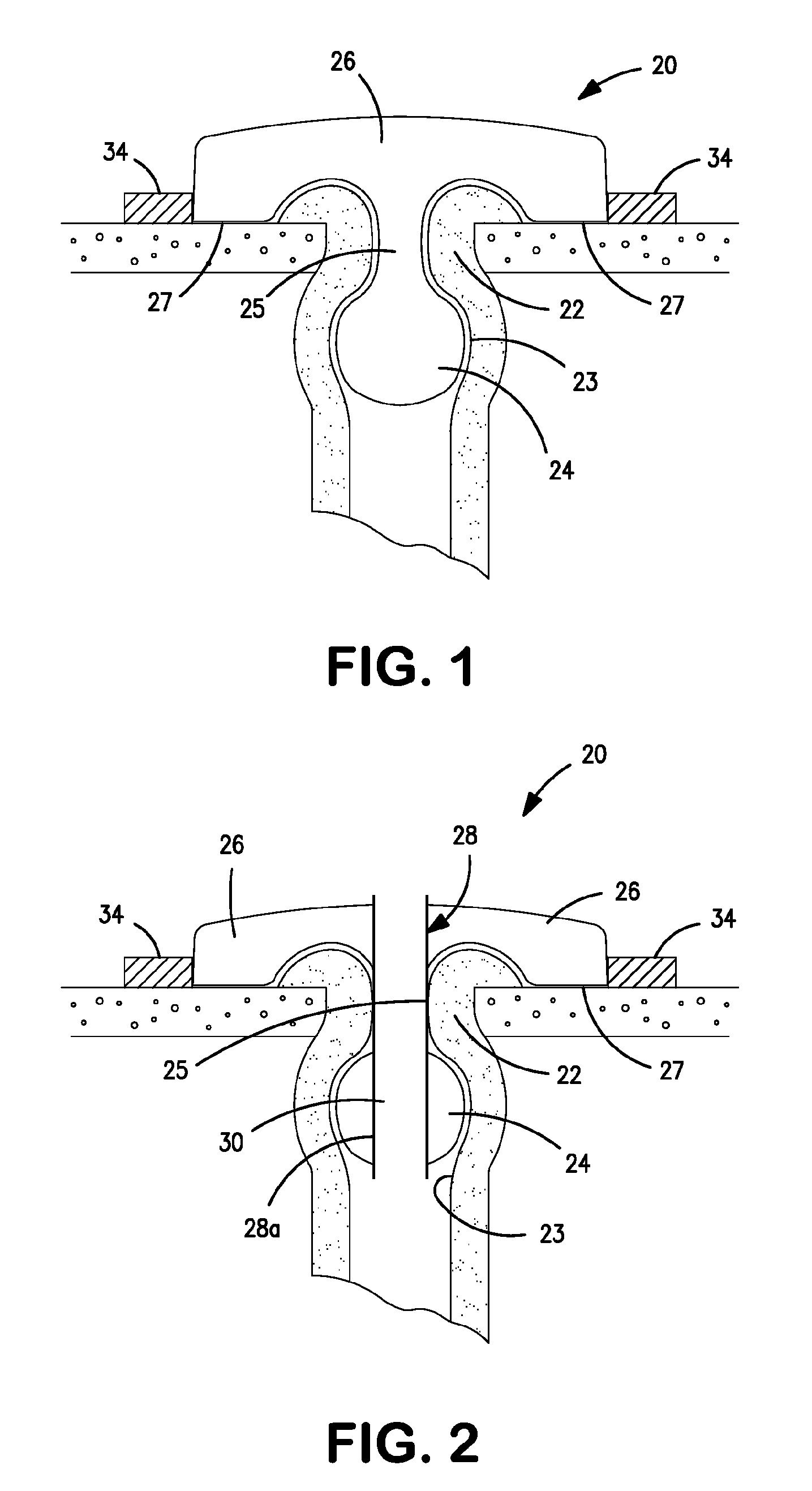Seal for an ostomy appliance
a technology for sealing ostomy and ostomy, which is applied in the field of sealing ostomy appliances, can solve the problems of high concentration of force on the tissue underneath the stoma, the risk of damage to the sensitive internal tissue, and the external protection of the patient, so as to achieve comfortable and effective peristomal sealing and protect the patien
- Summary
- Abstract
- Description
- Claims
- Application Information
AI Technical Summary
Benefits of technology
Problems solved by technology
Method used
Image
Examples
second embodiment
[0041]The second embodiment may optionally further comprise a support 28 for supporting the first and / or second chamber portions 24, 26. The support 28 may be of any suitable shape for supporting the first and second chamber portions 24, 26 in use. For example, the support 28 may include, or be formed as, a stem acting as a backbone for the first and second chamber portions 24, 26. The stem may pass generally centrally through the first and second chamber portions 24, 26. The stem may be at least partly deformable, for example, resilient, so as to avoid hard edges inside the stoma 22. The stem may be of a material that is generally stiffer than the flexible sealing walls of the first and second chamber portions 24, 26, or may inflate itself, becoming more structurally rigid upon inflation of the device, or may be constructed of the same material as the first and second chambers 24 and 26. The first and second chamber portions 24, 26 may meet, or be connected to or at the stem.
[0042]...
third embodiment
[0043]Referring to FIGS. 3-5, the ostomy appliance 20 is described for sealing around a stoma opening 22 in a person's abdominal wall 32. The ostomy appliance 20 comprises an adhesive wafer 34 of a skin-friendly adhesive, and having an aperture 36 therein which is larger than the size of the stoma 22. By using a larger aperture, the adhesive does not adhere to the sensitive external tissue of the stoma 22 or the peristomal tissue 27, and the ostomate avoids associated pain in the sensitive external tissue of the stoma 22 or the peristomal tissue 27. A flange 38, for example, of plastics, is secured to the adhesive wafer 34, for example, by heat welding, or adhesive. The flange 38 supports a flexible annular rear wall 40 which in turn is coupled to a generally flat portion (base) 28b of a T-shape hollow support 28, or is coupled to the edge of a tubular-shaped hollow support 28 that has no flat portion 28b. The support 28 also includes a hollow stem 28a depending from the base 28b, o...
sixth embodiment
[0051]Referring to FIGS. 8-11, ostomy appliance 20 comprises an integral component 68 comprising a faceplate 70 having a front surface 72 and a rear surface 74, and an aperture 76 for passing stomal waste; a stem 78 projecting rearwardly from around the aperture 76; a first inflatable chamber 24 disposed near or at the distal end of the stem 78, and a second inflatable chamber 26 disposed on the rear surface 74. The faceplate 70 is optionally relatively rigid compared to one or more of the other materials defining the chambers 24 and 26 and the stem 78, to provide a support for at least the second chamber 26, and / or to reduce the external profile height of the component when in use. The stem 78 can be hollow and communicate with the aperture 76 of the faceplate, to provide a discharge passage for stomal waste without having to remove the component 68 from the stoma 22.
[0052]In the illustrated embodiment, the integral component 68 is made from two pieces, namely the faceplate 70, and...
PUM
 Login to View More
Login to View More Abstract
Description
Claims
Application Information
 Login to View More
Login to View More - R&D
- Intellectual Property
- Life Sciences
- Materials
- Tech Scout
- Unparalleled Data Quality
- Higher Quality Content
- 60% Fewer Hallucinations
Browse by: Latest US Patents, China's latest patents, Technical Efficacy Thesaurus, Application Domain, Technology Topic, Popular Technical Reports.
© 2025 PatSnap. All rights reserved.Legal|Privacy policy|Modern Slavery Act Transparency Statement|Sitemap|About US| Contact US: help@patsnap.com



